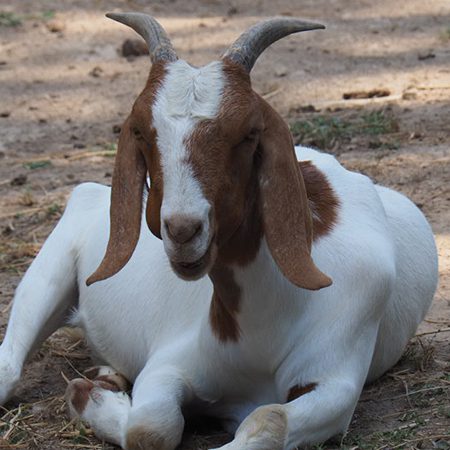Nubian Goat
Capra aegagrus hircus
The Nubian Goat, also known as the Anglo-Nubian goat outside of North America is a breed of domestic goat originating in the United Kingdom. This breed was the result of crossbreeding between native British goats and a mixed population of lop-eared goats from middle eastern regions including India. When this goat was first brought to the United States by European settlers from England, the Nubian goat was originally used for its milk production and meat. Today, the Nubian goat has moved away from meat production, but continues to be used as a popular dairy goat.
This Nubian goat breed is larger and carries more flesh than other dairy breeds of goat. Nubians have long, drooping ears that extend at least one inch beyond the nose. They come in a variety of colors and can be solid, spotted, or a combination of colors; the hair is generally short, fine, and glossy. These goats weigh anywhere between 135 to 175 pounds, with their height ranging between 2.5 3 feet tall.
Say Hello To Cub Creek's Goats: Niall, Amelia, & Otis
Niall was donated to us in May of 2016 and was only a year old. Amelia came to this camp during the summer of 2018 as a young kid. She was bottle raised and grew up in the nursery. Her favorite activities include playing with people (her favorite game is headbutting), and finding food. Otis came to camp as a 3 month old kid in June of 2017. He is a very spunky goat with a big personality; he loves meeting people and getting pets. You can find him with most of our other hoofstock in the back pastures in the summer.

Nubian Goats originated in the United Kingdom. Since then they’ve been transported to North America.
HABITAT -They can live in hot climates, typically living in temperate climates grazing in fields.
DIET -Sufficient amounts of grass for grazing can sustain them, supplemented by hay. They will also forage for tree and plant leaves.
FUN FACT -On average the milk produced by this goat is 4.5% to 8% butterfat!
SOCIAL BEHAVIOR -They live together as social herd animals, also very sociable with humans.
ACTIVITY -They are diurnal, being active during the day and sleeping during the evening.
PREDATORS -Predators of the Nubian goat are coyotes, wild dogs, wolves, bears, and cougars.
SIZE -Weigh between 135 to 175 pounds, with their height ranging between 2.5 to 3 feet tall.
RELATIVES -They are related to several other breeds of goat and also closely related to the sheep.
CONSERVATION -The Nubian Goat is categorized as NE (Not Evaluated) species by the IUCN.
Cub Creek Animal Care Information
Housing - Our Nubian goats thrive in open pasture environments, with lush green fields for grazing. The pastures are enclosed with fencing to keep predators out, and provide a covered area to take shelter in extreme weather. We provide automatic water dispensers that always keep fresh water for them.
Diet - The majority of our Nubian goats’ diet consists of grains and hay. This provides well balanced nutrition, supplemented by lush grasses they graze on. The food is provided to them in hanging food bucket containers, a feed trough, and hay feeders. Sometimes they enjoy special treats of various vegetables!
Enrichment - We love our goats and provide them with plenty of enrichment. Scatter feeding is a technique we use to help make mealtimes last longer, and allows them to eat slower. Since the food is more spread out rather than in one large pile, they must do a bit more foraging. They also have a goat playground inside their pasture! We also like to let them roam and explore outside of their regular grazing areas.


